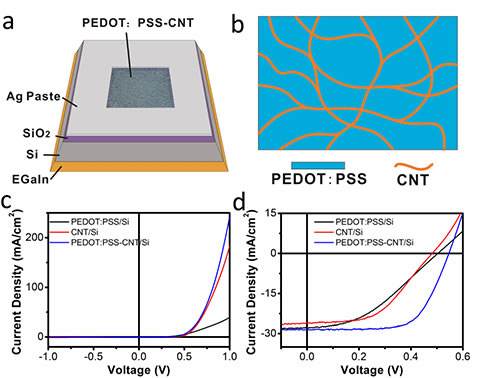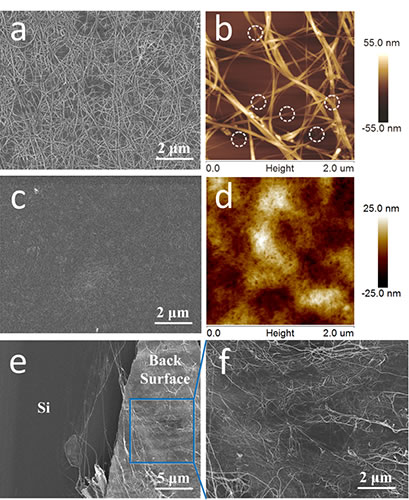At present, traditional silicon-based solar cells still occupy the mainstream photovoltaic market. However, the main factors that restrict the development of the silicon-based photovoltaic industry are high production costs and cumbersome preparation processes. Therefore, the development of high efficiency, low cost, large area and suitable for large-scale production of solar cells is imminent. The macroscopic carbon nanotube film has good mechanical, electrical and optical properties and is flexible. By adjusting the growth parameters, a high transmittance (up to 95%), high conductivity (105 S m-1) carbon nanotube films can be obtained. Carbon nanotubes and silicon can form pn junctions at room temperature without the need for high-temperature doping in conventional silicon-based solar cells. This new type of low-cost solar cell is easy to produce on a large scale and has a very broad application prospect. The organic conductive polymer can form a heterojunction with silicon under a mild condition by a solution method, which can also avoid the high temperature process required for preparing a pn junction in a silicon-based solar cell.
Institute of Physics, Chinese Academy of Sciences/Beijing National Laboratory for Condensed Matter Physics (CIC) Advanced Materials and Structure Analysis Laboratory “Nanomaterials and Mesoscopic Physics†research group has been researching the preparation, properties, and applications of carbon nanostructures for many years. . Recently, the research group doctoral students Fan Qingxia, Zhang Qiang, and Zhou Wenbin designed and prepared a new type of continuous network composite based on continuous direct growth of transparent conductive carbon nanotube network (ZL 201310164499.5) under the guidance of academician Chi Sishen of the Chinese Academy of Sciences and researcher Zhou Wei. The film's PEDOT:PSS-CNT/Si solar cell (Chinese invention patent, application number .7) has an energy conversion efficiency of up to 10.2%.
They analyzed the light transmittance and conductivity by analyzing the basic structure of solar cells of PEDOT:PSS/Si, CNT/Si and PEDOT:PSS-CNT/Si prepared from the same material under the same process conditions. Excellent CNT films and PEDOT:PSS are combined in a well-designed structure to give full play to the respective advantages of CNT films and PEDOT:PSS. First, PEDOT:PSS-CNT composite films have superior transparent conductive properties; second, PEDOT:PSS can fill voids in the CNT network, making PEDOT:PSS and CNT in common contact with silicon to form a pn junction compared to CNT/Si cells. The effective heterojunction area is greatly increased; more importantly, the CNT continuous network can be used as a carrier-transporting high-speed network, enabling the composite network film to increase the hole-transport capability of the p-type layer. The model and performance enhancement mechanism of the new-type structural battery are mainly attributed to the synergistic effect produced by the unique composite structure formed by the continuous network of PEDOT:PSS and CNT. This work provides a highly efficient, highly repeatable, easy-to-large-area photovoltaic device based on organic materials and CNT network composite thin films. The relevant research results were published in Nano Energy (2017, 33, 436-444).
The work was supported by the Ministry of Science and Technology (2012CB932302), the National Natural Science Foundation of China (11634014, 51172271, 51372269 and 51472264) and the Chinese Academy of Sciences (XDA09040202).

Fig. 1 (a) Schematic diagram of the structure of PEDOT:PSS-CNT/Si solar cell; (b) Schematic diagram of the back surface of PEDOT:PSS-CNT composite film; PEDOT:PSS/Si, CNT/Si and PEDOT:PSS-CNT/Si Solar cell (c) dark current density-voltage curve, (d) bright current density-voltage curve.

Fig. 2 (a) SEM image of carbon nanotube film, (b) AFM image; (c) SEM image of (d) AFM image of PEDOT: PSS-CNT composite film; (ef) PEDOT: PSS-CNT composite film and SEM image of silicon contact interface and back surface.

Figure 3 (a) Reflectance spectra of Si substrate, PEDOT:PSS/Si, CNT/Si, and PEDOT:PSS-CNT/Si solar cells; (b) CNT and PEDOT:PSS-CNT composite films at different spin coating rates Transmittance spectrum, inset: surface resistivity of PEDOT:PSS and PEDOT:PSS-CNT composite films at different spin speeds; (c) thickness of PEDOT:PSS and PEDOT:PSS-CNT composite films at different spin speeds; (d) ) dV/dJ-(J+Jph)-1 curves for PEDOT:PSS/Si, CNT/Si, and PEDOT:PSS-CNT/Si solar cells.

Fig. 4 (a) Ultraviolet photoelectron spectrum of PEDOT:PSS-CNTs; (b) Energy band diagrams of PEDOT:PSS/Si, CNT/Si and PEDOT:PSS-CNT/Si solar cells; (c) PEDOT: PSS-CNT/Si solar cell model.
Polyurethane System For Safety Shoe Sole
Safety Shoes Materials,Polyester Polyol Isocyanate,Shoe Sole Polyurethane Resins,Shoes Outsole Pu Material
XUCHUAN CHEMICAL(SUZHOU) CO., LTD , https://www.xuchuanchem.com